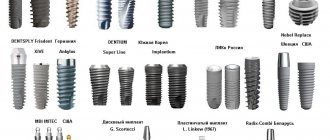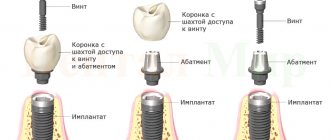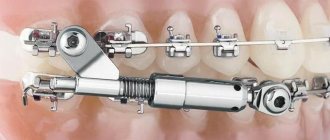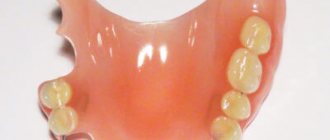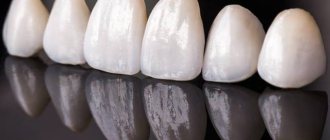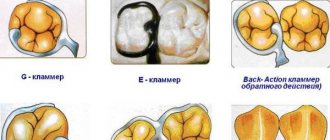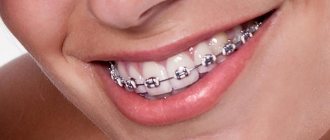From this article you will learn:
- What is an implant
- Pros and cons of implants
- Types of implants
- Installation methods
- Rehabilitation and rejection after the procedure
- Implant failure - what to do in this case
- Contraindications
- Questions and answers?
Losing a tooth relieves pain and inflammation, but gives rise to other problems. The chewing process is disrupted, and displacement of molars and premolars may begin. Therefore, it is necessary to restore the integrity of the dentition. Installing dentures and bridges is inconvenient and not always possible. Implants combine convenience, reliability, safety and guarantee a beautiful smile.
What is an implant
A dental implant (implant) is an artificial multi-component structure that is installed into bone tissue. After fusion, crowns are fixed to it. In simple terms, an implant is an artificial root that performs all the functions of a lost tooth.
A dental prosthesis is implanted into bone tissue. Then an abutment (periosteal element) and a crown are mounted on it.
Dental implant
Indications for installation are partial or complete edentia, restoration of lost incisors, molars, premolars and canines.
What is the difference between some features and characteristics
Surface type
The main factor influencing survival rate. High quality models are sandblasted with alumina or aluminum oxide and then acid etched. Micropores with a diameter of 3-10 microns are formed on the implant, into which bone tissue penetrates, ensuring high stability of the structure.
For faster engraftment, manufacturers have developed ultra-hydrophilic SLA surfaces , which promote rapid deposition of fibrin threads between the implant and the bone. To speed up the synthesis of bone tissue, a thin layer of calcium phosphate, fluorine or phosphorus ions is applied to the surface.
Form
Rods are produced:
- cylindrical - smooth models with a porous surface;
- conical screws - reminiscent of self-tapping screws that are screwed into bone tissue;
- lamellar - the base in the form of a flat long plate is installed in a narrow bone.
For dense bone, cylindrical implants without aggressive threading are indicated. For soft ones, conical models provide stability.
Thread (mount)
The carving is made in accordance with the characteristics of the bone tissue - D1 (the densest), D2, D3, D4 (the softest). Bone D2 is best suited for implantation, D4 is worse. The difficulty is that the jaw can have different densities both in height and in different areas. To achieve the desired results, manufacturers apply 2-3 types of threads to the rods. Such designs were distinguished by the highest survival rate.
Pros and cons of implants
Installation of pins in bone tissue requires the experience and practical knowledge of a maxillofacial surgeon and implantologist. And fulfillment of all his prescriptions by the patient. In addition, before implantation, the oral cavity is sanitized and any inflammatory processes are stopped.
| pros | Minuses |
|
|
Table. Advantages and disadvantages of implants
Stages of implant installation and timing
The implantation procedure can be one-stage or two-stage. With a one-step procedure, all steps can be completed in one day, which is why it is sometimes called express implantation. But it still takes several months for the implant to fully heal, during which you cannot put full load on the artificial tooth. Another feature of one-stage implantation is the installation of a one-piece structure (implant + abutment), so if necessary, replacing it will present a certain difficulty.
Two-stage implantation includes the installation of an implant, and after a certain period (3-6 months) a permanent crown is placed on it. This requires several visits to the dentist, but in many cases this process is more justifiable for medical reasons. It is less risky and allows for more careful monitoring of the condition of the oral cavity at all stages of treatment.
The installation stages and timing of dental implantation depend on the specific situation, the anatomy and physiology of the patient, his financial capabilities, as well as the treatment plan chosen by the doctor.
It is also necessary to understand that in addition to the implantation procedure itself, diagnostics are also required (X-rays and tomograms, blood tests), treatment of caries on all teeth, removal of teeth that cannot be restored, taking impressions and making crowns, and in some cases, bone grafting. All this also takes time and sometimes significant time.
Preparation for implantation: diagnostics and modeling
Before implantation, you must visit the doctor at least 2 times. The initial consultation allows the implantologist to examine the oral cavity, get acquainted with the patient’s wishes, assess the prospects for treatment, and also take the necessary x-rays and tomography showing the condition of the jaw bone tissue and the presence of externally invisible features and pathologies of the dentition.
After this, the doctor prescribes:
- laboratory tests (tests),
- consultations with related specialists (at least an orthopedist and anesthesiologist, and in the presence of chronic diseases - specialized doctors: a cardiologist, an endocrinologist),
- sanitation of the oral cavity (treatment of caries and other diseases, professional cleaning, as well as removal of teeth that cannot be treated),
- correction of existing dentures and crowns,
- if necessary, bone grafting.
After completing all the established measures and removing obstacles to implantation, the doctor checks the condition of the oral cavity and sets a date for the operation, concludes an agreement, and talks about how to prepare for the operation.
Installing implants is only half the battle. After this, it will be necessary to install crowns on them. To do this, the patient's jaw is modeled. Photometry is performed - photographs of the face are taken in different positions, the facial arches are studied, then the characteristics of the bite are studied, and the work of the temporomandibular joint is examined. After this, a 3D model of the jaw is created, on which the doctor plans the installation.
Surgery: installation of implant and healing abutment
How long does it take to install an implant? The operation itself can be performed in different ways, depending on the choice of method, type of material, and other reasons. If we talk about the most common case of two-stage endosseous implantation, it is carried out as follows: the doctor makes incisions in the gum, drills a hole in the jawbone and installs a root-shaped screw implant, after which the gum is sutured around the implant, completely covering it. After a few days, the doctor removes the stitches. After 3-6 months, the gum is opened and a gum former is placed on the implant, and after another 2-3 weeks - an abutment and crown.
Incisions can be made not with a scalpel, but with a laser - it is believed that this is less painful (the dose of anesthetic can be reduced), produces less bleeding, and there is no need for stitches after laser implantation. But this method significantly increases the cost of implantation (by 30-60%).
Orthopedics: prosthetics on implants
This is the final stage of dental restoration using implantation, which reproduces the functionality and aesthetics of the dentition. Orthopedic structures of 3 types can be installed on implants: a single crown, simulating one missing tooth, a bridge prosthesis, replacing several lost teeth in a row, and a complete prosthesis, simulating the entire dentition.
According to the stage at which orthopedic structures are installed that transfer the load to the implant, there are:
- implantation with immediate loading - the crown is placed immediately, immediately after the operation, or within 72 hours after it, this is the fastest method, but the risk of material rejection is maximum here,
- implantation with early loading - the crown is placed within 4-6 weeks after implantation, with a temporary crown usually placed, which is replaced with a permanent one a few months later,
- implantation with late loading is the most traditional method, in which the risk of rejection is minimal, since the chewing load, which can damage the fusion of the implant with the bone tissue, is transferred to the tooth after the material has engrafted.
With two-stage implantation with late loading, the risks are minimized, since the implant rests for several months without chewing load, and the likelihood of infection is also minimal due to the fact that the implant support area is hidden under the gum.
When making prosthetics, it is imperative to take into account the compatibility of materials in order to eliminate the possibility of breakage of the prosthesis, as well as to hide the possible transmission of the supporting structure through the translucent material of the crown.
Types of implants
Currently, many types of dental structures have been developed that will help solve any patient’s problem. The choice of implant is the prerogative of the doctor. And it depends on the diagnosis and individual characteristics of the patient.
By purpose
There are 2 groups of dental structures – intraosseous and extraosseous. The first ones are made of titanium alloys. They reproduce the shape of the tooth and are made with or without threads. Their surface is specially treated to increase the speed of osteosynthesis. Screw implants are the most common.
Screw implants
Extraosseous structures are indicated when it is impossible to use intraosseous titanium pins.
Types of dental implants:
- subperiosteal - indicated for insufficient bone tissue. Allows you to avoid sinus lift surgery. Installed in the periosteum, between the bone structures and the gum;
Subperiosteal implants
- stabilizing – help preserve the tooth root, making it longer. They are classified as temporary structures and are currently practically not used;
Stabilization implants
- intramucosal - installed in the mucous membranes, bone tissue is not affected. Used to attach removable dentures.
Intramucosal implants
According to the type of fixation in the bone
Based on the method of fixation in tissues, root, basal and zygomatic dental structures are distinguished.
Root - the most popular, are a threaded cylinder. Can be installed if there is a lack of bone tissue.
Basal - began to be used relatively recently. They are installed in deeper bone structures (basal bone). Their installation does not require sinus lift surgery; they are suitable for one-stage implantation and better distribute the load during chewing.
Zygomatic pins – used in cases where other methods and types of dental implants are contraindicated. They are mounted in the zygomatic bone, which makes it possible to restore the upper dentition in case of complete atrophy of bone tissue.
By design
There are one-piece, two-piece and mini-implants. The former are used for express methods of restoring a lost molar, incisor or canine. In them, the abutment is already fixed to the intraosseous part of the device. When installed above the gum, the top of the one-piece implant remains. You can immediately install a crown on it.
Two-piece ones consist of a titanium pin itself, which is immersed in the bone. Several months should pass after its installation. This implant has a recess onto which the abutment is attached. This allows, if necessary, to replace the upper part of the structure without removing the pin. This is the most popular type of implant.
One-piece and two-piece implants
The smallest dental structures are mini-implants. Their sizes range from 1.8 to 2.4 mm. The installation is painless and takes root within a month. The crown or prosthesis is installed 3 days after implantation. They are used, as a rule, for attaching removable dentures.
Mini implants
By class and manufacturer
Today, there are 3 classes of titanium pins on the dental construction market - economy, medium and premium segment.
Premium class implants are distinguished by higher quality materials and have greater capabilities. They are recommended for use in difficult cases. They are easier for the dentist to work with. In addition, the manufacturer offers many additional elements, crowns, and abutments.
Well-known manufacturers of titanium structures in dentistry:
- Straumann and Nobel Biocare (Switzerland);
Straumann implants
- Denstply – products under the TM Ankylos, Xive Friadent (Germany), Astra Tech (Switzerland);
- MIS, AlphaBio, Ards (Israel);
MIS implants
- MegaGen
MegaGen implants
Economy and mid-range segments are no worse in quality. And you need to understand that when implanting, the main thing is the knowledge and skills of the dentist.
Implantation methods for complete absence of teeth
Trefoil
Trefoil technology is a new method of dental implantation. The technique was created exclusively for the restoration of teeth in the lower jaw with complete edentia. The advantage of the technology is that the permanent fixed prosthesis is installed immediately on the day of implantation on a titanium bar with an innovative fixing mechanism, which ensures passive fit of the orthodontic structure. The base follows all the curves of the real lower jaw, and adaptive connections hold the artificial roots in the correct position. The use of a small number of implants significantly reduces the cost of prosthetics.
All-on-4
The All-on-4 method is a patented development of Nobel Biocare. The operation according to the protocol involves the installation of only four implants to restore all the teeth in the jaw. Immediately after implantation, provided there is good primary stability, titanium roots can be loaded with a fixed prosthesis. The peculiarity of the operation is that the implants are fixed in the lateral part of the upper jaw at an angle of 45 degrees, bypassing the maxillary sinuses. Abutments with inclined fastening (multi-unit) are selected for them. The two remaining implants are installed at right angles to the front teeth. Implantation using the All-on-4 method is especially effective in cases where it is not possible to grow bone tissue due to the physiological characteristics of the patient’s body.
All-on-6
The All-on-6 technique is an improved All-on-4 implantation technology. Two titanium rods are fixed vertically in the frontal zone, four - in the chewing sections at an angle of about 60 degrees. The implants do not affect the maxillary sinuses. Compared to the All-on-4 technology, when using the All-on-6 protocol, the chewing load is distributed more evenly due to the increased number of implants.
Life time
Manufacturers provide an almost lifetime warranty on dental structures. For example, Alpha Bio is 30 years old, but if a pin fails within 5 years after installation, it will be replaced free of charge. And Astra Tech, MIS, Nobel, Straumann, Osstem and Biohorizons, Ankylos will replace them regardless of the service life of the device.
Crowns that are installed on an artificial root are designed to last 10–15 years.
Factors affecting the service life of the device:
- professionalism of doctors who are involved in the implantation process;
- quality of titanium pins;
- condition of teeth, bone structures, general medical history of the patient;
- quality of oral care after installation of a dental structure.
Important! A mandatory condition for providing a guarantee is an annual dental examination.
The main advantages of two-stage implantation
1. Traditional technology shows the highest rates of successful implant survival. The implantologist, by opening the gum and making an incision on the bone, gains high-quality access and visibility necessary for strong fixation of the implant.
2. Two-stage implantation is applicable to solve the problem of both single and multiple dental defects.
3. The ability to place a crown made of any material on the implant.
4. The patient can choose, together with a specialist, implants for the operation - budget or premium, depending on his financial capabilities.
5. The use of a gum former makes it possible to obtain high aesthetics of the restoration. The crown will look as natural as possible.
Despite the many advantages of traditional implantation, there are also a number of disadvantages that you should know about in advance.
Installation methods
The classic method of implantation is surgery, followed by a long period of osteosynthesis. Modern techniques make this process easier and faster.
Types of dental implantation:
- Traditional – carried out in 2 stages. The crown is installed six months after implantation.
- One-stage – the crown is installed immediately after implantation.
- Basal – pins are installed in the basal bone; sinus lift surgery is not required.
- Translingual - the artificial root is inserted through small punctures. The technique is considered minimally invasive. The crown is fixed after 3–4 days.
The method of installing dental structures is chosen by the doctor. It depends on the patient’s diagnosis and associated factors.
Cost of different types of implantation
An important factor in choosing the type of implantation is the price. To make it easier for you to decide on the method of installing implants, we have indicated in the table below the approximate cost of all types of implantation that are in demand in modern dentistry. Therefore, you will not find prices for endodontic-endosseous, subperiosteal and transosseous techniques in it, since these types of implantation are no longer used.
| Type of implantation | Price for installation of one implant |
| Endosseous (intraosseous) implantation | 20 -35 thousand rubles. |
| Basal implantation | from 35 thousand rubles. |
| Intramucosal implantation | from 20 thousand rubles. |
| Laser implantation | 40 -60 thousand rubles. |
| Express implantation | from 40 thousand rubles. |
Rehabilitation and rejection after the procedure
Installation of a titanium pin does not require hospitalization and is performed under local anesthesia. After the procedure, the patient goes home. Survival rate and the absence of complications depend on the quality of oral care and compliance with the dentist’s prescriptions.
Recommendations for nutrition for 3 days after surgery:
- do not eat for 3 hours after the procedure;
- the first day - soft, warm, non-acidic and non-spicy food;
- chewing load - only on the healthy side;
- Alcohol and smoking are prohibited;
- It is advisable to exclude coffee and tea; the best option is herbal tea, unsweetened compote;
- observe the drinking regime.
Attention! Alcohol after implantation is completely and categorically prohibited. It promotes the destruction of bone tissue and slows down the healing process. In addition, the doctor will prescribe antibiotics. Alcohol intake is dangerous for the patient's life.
Hygiene rules:
- there is no place for hands in the mouth;
- 3–4 days – only oral baths with prescribed medications, rinsing is strictly prohibited;
- 3–5 days after examination by a doctor, you are allowed to use a toothbrush;
- 2 weeks after implantation, start using an irrigator.
After surgery, buy a new toothbrush. This way you will reduce the risk of wound infection by pathogenic flora.
After implantation it is strictly prohibited:
- using electric toothbrushes;
- brushing teeth with floss;
- carry out hygienic cleaning without a doctor’s referral - the dentist must know and be able to work with implants. Therefore, only as prescribed by the implantologist;
- chew nuts, pencils, bite any hard objects.
Smokers should give up cigarettes at least until the stitches are removed. Then after each smoking session you need to do a mouth bath with chlorhexidine.
Intramucosal
Unfortunately, many people know about the inconvenience of removable and conditionally removable dentures in use. This is why dental industry professionals have developed a new technology called intramucosal implantation. This approach made wearing prostheses more comfortable, and the aesthetic indicators became much higher. Now it has become possible to reliably fix implants even with serious pathologies of the development of the palate and bone tissue of the upper jaw.
In addition, intramucosal implantation allows for savings. Its cost is significantly lower compared to alternative options. For this purpose, composite pins are used: one part is fixed under the mucosa, and the other directly on the removable denture. Externally, the fastenings are completely invisible even upon closer inspection.
The supporting elements are installed in a drilled hole in the gum, which is made using a dental bur. The bed is shaped like a hole, but shallow. The crown part of the tooth can be put on immediately, it is very easy. The patient will be able to do this independently without much effort, for example, during daily oral hygiene. There is only one limitation: the thickness of the mucous membrane must be at least 2.2 mm.
Implant failure - what to do in this case
Rejection is an inflammatory process that is accompanied by the destruction of bone tissue. Causes pain, swelling of the gums, bleeding, and purulent exudate.
Types of rejection:
- early – begins immediately after surgery – the main reason is a violation of implantation protocols;
- medium-term – 1.5–2 years after installation of the pins. The reasons are various – from hormonal imbalance to increased chewing load on the implant;
- later – after 2.5–3 years – the main reason is violation of hygiene rules.
Rejection is an extremely rare complication after the installation of a dental structure. If any alarming symptoms appear, you should contact a medical facility.
FULL CONSTRUCTION
Cost of implantation of 1 tooth on a turnkey basis:
cost of installing an implant, plug, gum former, work of an implant surgeon, installation of an abutment, work of an orthopedist, impression of the jaw, laboratory services and work of a technician, cost of a metal-ceramic crown*
* cost of zirconium crown
*The cost of dental prosthetics is indicated for the installation of a metal-ceramic crown. When prosthetics on implants with a zirconium crown, the cost increases by 10,000 rubles
* the promotional price for the installation of dental implants is valid for two implants or more
| Implantation system | Implant installation | Installation of the driver | Prosthetics* | TOTAL |
| 20 000 | 3 000 | 20 000 | 43 000 | |
| 20 000 | 3 000 | 20 000 | 43 000 | |
| 40,000 per promotion 35 000 | 5 000 | 40 000 | 85,000 per promotion 80 000 | |
| 40,000 per promotion 35 000 | 5 000 | 40 000 | 85,000 per promotion 80 000 | |
| 40 000 | 7 500 | 40 000 | 87 500 | |
| 40 000 | 5 000 | 40 000 | 85 000 | |
| 40 000 | 5 000 | 40 000 | 85 000 | |
| 25 000 | 5 000 | 25 000 | 55 000 | |
| 20 000 | 3 000 | 20 000 | 43 000 | |
| 20 000 | Installation of the mating part in a complete removable denture 3 000 – 5 000 | |||
Our doctors will select the best solution to the problem of missing one or more teeth, help you understand complex issues and draw up a plan for successful dental treatment.
Contraindications
All contraindications are divided into absolute and relative. It is strictly prohibited to install titanium pins in the following cases:
- blood diseases – the risk of bleeding and implant rejection increases;
- active cancer, during chemotherapy and radiotherapy – the risk of metastasis increases;
- diabetes mellitus in the stage of decompensation;
- taking cytostatics, any immunodeficiency states;
- intolerance to local and general anesthetics.
Previously, the list of contraindications to dental implantation was wider. But modern technologies and improved surgical techniques have expanded the capabilities of both patients and doctors.
Relative contraindications:
- pregnancy and lactation - any operation causes stress. Therefore, it is better to postpone the procedure until the end of breastfeeding;
- malocclusion - first correction, then installation of pins;
- inflammatory processes in the mouth, nasopharynx;
- exacerbation of any chronic disease.
In addition, it is forbidden to install implants before the age of 18, since the bone tissue is still forming. Old age is not a contraindication for dental implantation.
Dental implantation in Khimki – prices
Currently, there are quite a lot of dental implantation clinics , Moscow , of course, is no exception. However, many people are put off by the prices of dental implants in Moscow . It is worth admitting that the prices for dental implantation in Moscow are really quite high. This is determined by the rather high cost of the dental implantation systems themselves, and the rather labor-intensive process of preparing for the procedure and its implementation. Often, prices for installing a dental implant in Moscow are inflated due to the “status” of the clinic and the prohibitively high costs of renting premises, purchasing equipment and consumables.
If you are looking for a good clinic and want to get the best price/quality ratio, pay attention to the Apex-D dental implantation clinic, which installs dental implants in Khimki . Highly professional specialists with extensive experience in dental implantology, working on modern equipment, having at their disposal a wide selection of dental implantation systems - all this will allow you to install implants that best meet your requirements and wishes. The doctors of our clinic will help you choose implants that fully correspond to any clinical situation that requires prosthetics on implants. Well, the prices will satisfy patients with different income levels; in any case, we will select the most acceptable prices for dental implants in Moscow .
Questions and answers
Is it painful to have implants installed?
Implantation is a full-fledged operation. It is performed under local anesthesia or general sedation. The choice of drug and method of administration is the prerogative of the doctor. After the operation, the dentist will prescribe adequate pain relief.
Is there a difference in installation between the upper and lower jaw?
Yes, the roots of the teeth of the upper jaw abut or enter the upper maxillary sinus. Before implantation, an operation is required to lift the bottom of the sinus and build up bone tissue. In addition, in some cases, zygomatic implants are used. Bone augmentation to install a pin in the lower jaw may not be performed. This depends on the results of the patient's examination.
At what age are implants placed?
From 18 years and older. Old age is not a reason for refusing to install a dental structure. The procedure is allowed at both 70 and 80 years of age.
Is it possible to do an MRI after implantation?
Dental implantation is not a contraindication for either MRI or CT. The dental structure is made of titanium alloy. During the procedure, it will not heat up, will not move, and will not cause pain.
Transgingival implantation
This technique is recognized as the most gentle, as it allows you to achieve reliable and durable results without unnecessary injuries and shorten the rehabilitation period.
While there are different types of implantation, modern approaches strive to minimize surgical intervention. And this method is one of the most advanced and most popular.
A distinctive feature of transgingival or minimally invasive technology is the absence of the need for an incision in the gums and suturing. This reduces pain, discomfort, swelling, reduces the likelihood of infection and significantly reduces the risk of artificial root rejection.
The advantage of the method is also considered to be a shorter engraftment period.
The operation is carried out in several steps:
- puncture of the gums with a special instrument;
- if implantation is carried out immediately after tooth extraction, a puncture is not required, installation is carried out in the hole remaining after the root;
- implantation - the depth and angle of inclination are determined using computer modeling, which increases the accuracy of installation and avoids damage to adjacent teeth, penetration into the maxillary sinuses and nerve injury;
- installation of a gum former or temporary prosthesis;
- after 3-6 months - installation of a permanent crown or prosthetic structure.
When choosing an implantation method, the slightest nuances matter, which is why it is better to trust a specialist in this matter.
Free dental consultation
Our clinic offers a free examination by a dentist or implantologist. The doctor will examine the oral cavity and give recommendations for treatment and dental prosthetics.
You can read all the nuances of implantation in the article.
To find out more about prices for treatment and installation of implants, go to the appropriate section of our website. Registration for a consultation is carried out by phone and 7(920)-090-49-94, in the feedback form and during a personal visit to the clinic.
You can also find more information about installing implants in the article.
Subperiosteal
Today this method is no longer used, but it is worth mentioning. It was used when the patient for some reason did not want to undergo bone grafting or it was contraindicated. In this case, the implant was placed not in the ridge, but under the periosteum. The periosteum is the tissue that surrounds the bone. Thus, the implant was fixed from the side, under the thickness of the gum, and not into the socket, as with the standard approach.
Today, such an operation has been replaced by other methods of treatment, but previously this type of implantation enjoyed great success. It allowed me to get a good result without a long wait. For this purpose, special systems called subperiosteal systems were used. Outwardly, they looked completely different from their modern counterparts.
It was a small supporting frame made of hypoallergenic material with protrusions that were directed into the oral cavity. Such designs were created to order and only according to individual parameters, that is, a cast of the jaw was required. Based on the clinical picture and examination results, the doctor decided to perform the operation in one or two stages.
